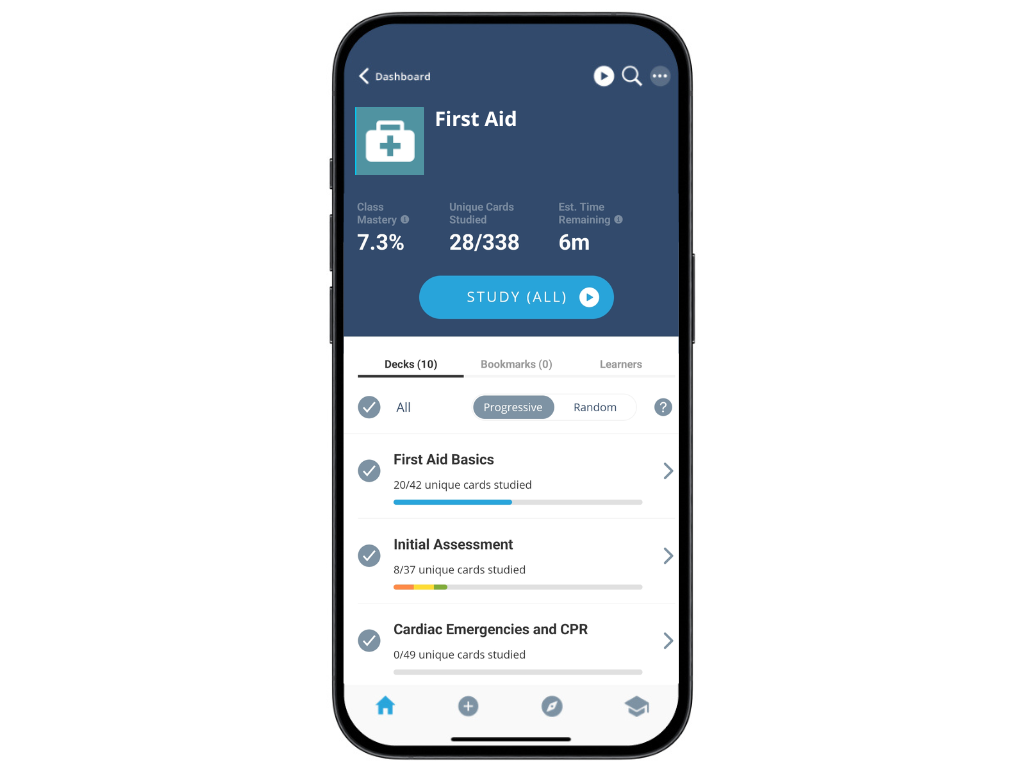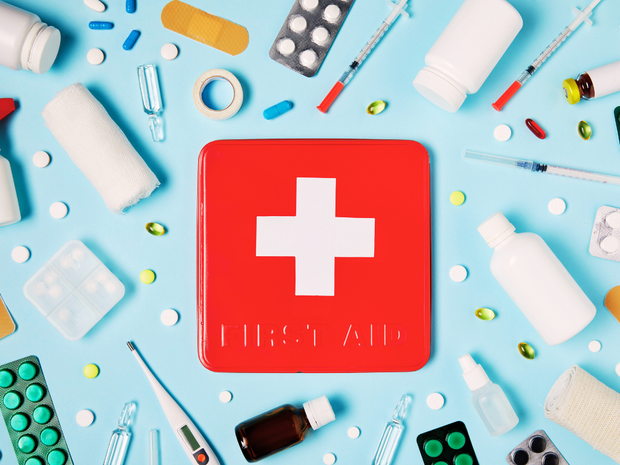So you’ve decided to become the person who knows what to do when someone yells, “Is there a doctor in the house?” (even though you’re not a doctor and definitely don’t want that kind of pressure). Good news: you don’t need to have a medical degree to offer potentially life-saving care for a huge spectrum of emergencies. You just need a first aid certificate. And we’re here to walk you through exactly how to get one!
Whether it's to boost your resume, meet workplace safety requirements, or give yourself peace of mind should an emergency arise as a parent, teacher, or guardian, first aid certification is one of the most empowering competencies you can earn. Let’s break down everything you need to know about first aid certification programs, as well as a nifty study tool that makes crushing the theory portion of the certification a total cake walk.
What are First Aid Basics & Who Needs Them?
First aid basics are the kinds of emergency care you administer or protocols you follow before the real medical professionals arrive, like the EMTs or paramedics. We’re talking about simple, yet potentially lifesaving skills like CPR training (cardiopulmonary resuscitation if you're fancy), stopping bleeding, and what to do if someone’s choking, burned, having an allergic reaction, or physically injured (and more).
It’s not magic. It’s not even medicine. It’s just clear, calm, practical help that can genuinely save lives.
And who needs this knowledge of first aid basics?
Well, aside from literally everyone, there are some specific groups who may be required (or strongly encouraged) to get certified:
- Parents and guardians
- Teachers
- Childcare providers
- Healthcare providers
- Coaches and fitness instructors
- Construction and industrial workers
- Lifeguards
- Flight attendants
- Outdoor guides
- Human beings with other human beings in their life
That last one? That’s probably you. Everyone should learn the essential skills needed to assist in common medical emergencies.
In short: if you’re wondering how to get first aid certificate credentials to help others (or meet the job requirements), this guide’s for you.
Why Is First Aid Certification Important?

Getting certified in first aid is fundamentally about learning how to act when someone gets sick, injured, or physically compromised. With a valid first aid certificate, you:
- Are prepared to assist in real-life emergencies
- Learn how to avoid making situations worse
- Help reduce the severity of injuries
- Can make a lifesaving difference while first responders are en route
- Meet workplace health and safety requirements
- Nod knowingly when someone attempts to perform CPR in a film
Taking a first aid class is a small investment of time and energy with the greatest potential reward: saving lives. Think of it as unlocking a real-life superpower, minus the cape (unless you’re into that).
Beyond individual benefit, first aid certification ensures communities are safer, workplaces are more compliant, and you’re legally protected in many jurisdictions. In some cases, completing a first aid certification program might even reduce liability for employers, so everybody wins.
How Do I Obtain My First Aid Certificate?
Step 1: Choose the Right Certification Course
Not all first aid courses are created equal. The one you need depends on your goals, job requirements, and how deep you want to go in the realm of emergency medical services.
The most common options include:
- Basic First Aid: Covers general emergencies like cuts, burns, fainting, etc.
- CPR/AED: Teaches you how to perform CPR and use an automated external defibrillator
- Pediatric First Aid Certificate: Essential for childcare workers or parents
- Workplace First Aid Certificate: Tailored for specific industries and often required by law
Some first aid training courses combine CPR certification with first aid in one training session, which is great if you want to be extra-prepared. There is a range of other courses that complement first aid, such as safety and evacuation training specific to a particular workplace. For example, if you work as a clinic receptionist in a building full of healthcare professionals, you might need to learn a range of protocols for different situations. Check what your employer or state requires and make sure the training materials cover those requirements before you book anything.
Step 2: Choose a Recognized Provider
You want training from someone legit. Look for courses from nationally recognized organizations like:
- The International or American Red Cross
- American Heart Association
- National Safety Council
- St. John Ambulance
- Your local health department or workplace training program
Importantly, make sure the course is OSHA-compliant if you're doing it for work.
Most first aid courses offer options for both in-person training and blended learning courses (online + in-person), depending on your location and the provider. Just know that if you complete first aid training online, your course will typically not be accepted for first aid certification without the addition of an in-person skills component. Online training doesn't cover practical knowledge, such as CPR training.
This makes sense, right? You can learn the rules of basketball from ChatGPT but you won't be able to play until you get onto an actual court!
Step 3: Study for the Theory Portion Using a Flashcard App
Even though most first aid training is hands-on, there’s usually a written or online knowledge test involved. That means you need to understand the why behind each emergency action, not just how to do it.
And this is where that nifty study tool I mentioned in the introduction comes in!
Digital flashcards.

It's flashcards, just digitized (so, on your phone and laptop). You may have used flashcards in school, but digital flashcards are next-level efficient for learning all the theory you could get tested on in any basic first aid program as efficiently and painlessly as humanly possible.
The best flashcard app for the job is Brainscape because we've already broken down all of the testable knowledge content into a collection of expert-curated first aid flashcards, which you can start studying right away.
These First Aid flashcards are designed to help you learn twice as fast using a study tactic called spaced repetition. In fact, there's a whole elegant science to the way Brainscape works (<– and you can learn more here), but to summarize it all, the web and mobile app empowers you to:
- Study in short, focused bursts
- Track your progress
- Build long-term memory
- Quiz yourself on the go
- Feel confident heading into your first aid certification course (or real-world emergencies)

No more blanking on the steps of CPR just because you read it once a week ago. With Brainscape, you’ll actually remember what to do in emergency situations, and why.
Step 4: Attend the Course and Practice Your Skills
This is where the fun begins. During your first aid course, you’ll get hands-on practice in things like:
- Performing chest compressions on a mannequin
- Bandaging wounds
- Responding to mock emergencies
- Using an AED correctly
- Training to stay calm while everyone else freaks out
It’s interactive, useful, and often surprisingly fun (especially if you enjoy fake blood and plastic limbs).
Instructors will walk you through real-life scenarios and give you a chance to try your skills in a safe, supportive environment. Some first aid training providers even simulate group disaster drills for realism.
Step 5: Pass Your Assessment and Get Certified!
Most first aid certification courses end with a short written test and a practical skills assessment. Don’t worry! If you’ve been paying attention during training (and studying with Brainscape), you’ll crush it.
Upon completion, you’ll receive your first aid certification, which is usually valid for at least two years, depending on the provider and course type.
Some certificates are digital; others are physical. Either way, you can add it to your resume, share it with your employer, and rest easy knowing you’ve got a valuable life skill under your belt.
FAQ on Getting First Aid Certified
What is Basic First Aid & Who Needs It?
Basic first aid is immediate care given in an emergency before professional help arrives. Everyone benefits from knowing it, but this training is especially important for educators, caregivers, fitness trainers, and workplace safety professionals.
Why is First Aid Certification Important?
Certification ensures you’re prepared to respond effectively in emergency situations, meet job requirements, and provide basic treatment with confidence and skill.
Do First Aid Certificates Expire?
Yes, first aid certificates do expire and must be renewed to keep your skills up to date and aligned with the latest guidelines. The usual validity period is 2 years for CPR and 2–3 years for most general first aid training. Annual first aid recertification may be needed for certain industries or roles.
Can I Learn First Aid Online?
Yes (and no). You can learn first aid online, but in order to be certified (and actually competent in performing the protocols), you'll need in-person, hands-on training. High-quality training requires practical demonstrations, such as learning how to provide CPR and AED operation.
What Should I Do if My First Aid Certification Expires?
If your certification has expired, don’t panic. You won’t have to start from scratch, since continuing education credits are typically recognized. Most providers offer abbreviated first aid recertification courses that are quicker and more affordable than taking the full class again. There are multiple training options for recertification, including online courses. Just make sure you renew your first aid certification before your current one lapses, so you’re always ready to respond!
Final Thoughts: Get Certified, Stay Ready, Be Awesome

Now that you know how to get your first aid certification, the only thing left to do is… well, go get it!
Becoming certified isn’t just a checkbox. It’s a decision to be someone who shows up when things go wrong. Someone who knows how to help instead of panicking. Someone who, in the face of a twisted limb, a panicking parent, or a collapsed person, takes a deep breath and says, “I got this.” You're the one who is fully prepared to respond before the first responders.
And if you want a secret weapon to help you retain all the knowledge you'll learn in a first aid class and pass your certification with flying colors, you'll have Brainscape in your corner!
If you loved this article, you might also love...
